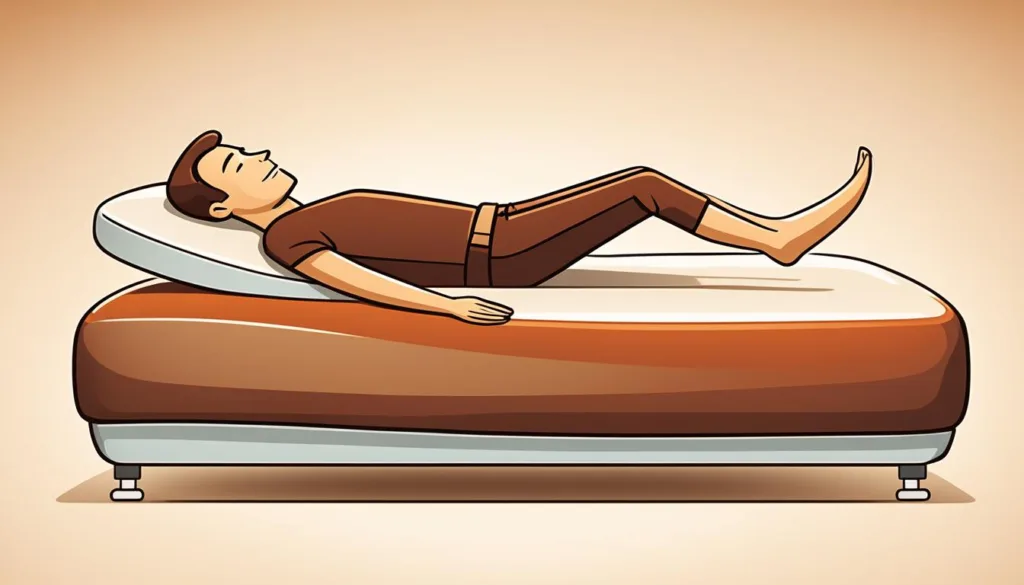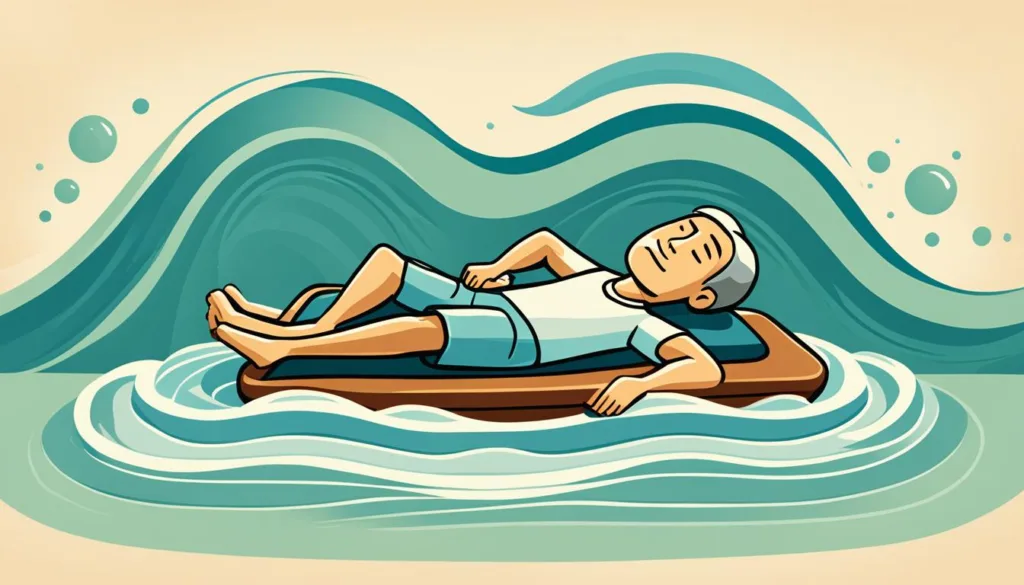Waterbeds Good for Back: Therapeutic Choices
Find Relief for Your Back: Exploring the Benefits of Waterbeds

Waterbeds Good for Back: Discover the therapeutic waterbed benefits that could usher in a new era of comfort for your back pain. These innovative sleeping solutions, once a staple of sleep innovation, have evolved to offer matchless comfort and support. With their distinctive ability to contour to your body’s unique pressure points, waterbeds are re-emerging as formidable contenders in the quest for a pain-free night’s sleep.
Comfortable waterbeds for back pain are not just about the nostalgia of the ’80s and ’90s; they deliver an array of health benefits by evenly distributing body pressure and reducing the stress on your spine. Plus, they come with a heating element that’s not found in standard mattresses, which can help increase blood circulation and relax tight muscles, potentially providing relief to those suffering from back discomfort.
Before diving into the comforting embrace of a waterbed, consult with a healthcare professional specialising in spine health. This crucial step ensures the features of the waterbed align with your specific back health needs.
Key Takeaways
- Waterbeds can contour to the body, offering tailored support for pressure points.
- The unique heat feature of waterbeds encourages blood flow and may assist in muscle relaxation.
- Therapeutic waterbed benefits may include improved spine health and comfort during sleep.
- It’s vital to consult with a spine specialist before opting for a waterbed to address back pain.
- Trying different types of waterbeds helps determine the ideal levels of firmness and support for your back.
Waterbeds Good for Back: Benefits of Waterbeds for Back Support
Are you considering a waterbed for its potential back health benefits? Let’s delve into how waterbeds could be good for your back and what orthopedic options are available. The unique structure of waterbeds allows for the displacement of pressure, which is essential for those seeking back comfort. Waterbeds have evolved to provide not just a novel sleeping experience but also possibly, orthopedic relief.
Studies on waterbeds have shown mixed results in their effectiveness for back pain relief. Some individuals find that the contouring and heat features of waterbeds improve their back comfort, while others report increased discomfort. This disparity in experiences underlines the necessity for personal testing of orthopedic waterbed options to determine what works best for your spine health.
Consider the key therapeutic benefits of waterbeds:
- Even distribution of body weight across the mattress surface
- Heat features that promote blood circulation, aiding in spine health
- Contouring properties that relieve pressure on the spine and joints
It’s essential to understand that individual preferences in firmness levels play a considerable role in the effectiveness of waterbeds for back support. While some people swear by the comfort of waterbeds, others might find more traditional mattresses more suitable for their needs. Here’s a concise table comparing orthopedic waterbed options to standard mattresses:
| Feature | Orthopedic Waterbed | Standard Mattress |
|---|---|---|
| Pressure Relief | High (Contours to the body) | Medium to High (Depends on mattress build) |
| Back Support | Adjustable (Water level changes firmness) | Fixed (Depends on mattress construction) |
| Heating Options | Available (Heating systems built-in) | Rarely available (Usually requires external heating pad) |
| Customizability | High (Can adjust water levels for desired firmness) | Low to Medium (Few models allow for customization) |
If you’re exploring waterbeds for back comfort, it’s advisable to consult with a healthcare professional and consider an orthopedic waterbed that suits your specific support needs. Remember, the right choice in a waterbed could potentially lead you to a more restful sleep, with the added benefit of enhancing your back health.
“Read also: Waterbeds In 1980s“
The Role of Heat and Contour in Waterbed Comfort
Discovering the comfort of waterbeds involves understanding how their unique design caters to back health. At the heart of their benefit lies the sophisticated combination of heat therapy and contouring support, designed to cater to the complex needs of spinal alignment for a restful night’s sleep.
How Heat Contributes to Spinal Health
Heat in a waterbed setting functions as more than just a source of cozy warmth. It acts therapeutically to enhance spinal health by increasing blood circulation. This not only provides essential nutrients to your spine but also ensures a rich supply of oxygen, crucial for the maintenance and repair of spinal tissues. Waterbeds Good for Back aren’t a mere luxury; they are a medium through which heat facilitates the natural healing processes.

Even Weight Distribution and Pressure Relief
While heated features draw soothing comfort, the aspect of even weight distribution tackles the physical support that your back demands. Waterbeds, known for their ability to contour perfectly to your body shape, provide an even weight dissemination, which drastically reduces pressure points. This translates into less strain on your muscles and joints that support the spine, offering substantial waterbeds for back support that can counter chronic discomfort. Nonetheless, users need to balance the benefits with a cautious approach, since the prolonged indulgence in massaging waves could potentially aggravate muscle stress, outweighing the pain-relief advantage.
If you’re seeking improved spinal alignment and relief from back pain, integrating the soothing heat and contour of a waterbed into your sleep regimen could be a game-changer. While every individual’s experience may vary, waterbeds and spinal alignment needs often align, offering a unique solution that traditional mattresses may lack. Embrace the comfort of a waterbed designed to cater to your body’s own landscape, potentially turning nights of discomfort into slumber-filled, therapeutic retreats.
“You may be interested in: Waterbeds For Sale“
Waterbeds Good for Back: Weighing Comfort Against Support
When considering a waterbed for back comfort, the balance between a soft, yielding surface and the necessary spinal support can make a difference in your sleep quality and back health. Though waterbeds can often provide a feeling of floating comfort, their lack of firmness might not serve everyone, especially when spinal alignment is paramount.
Understanding Spinal Alignment Needs
Spinal alignment is crucial for those suffering from back pain. A bed that is too soft may allow the body to sink in excessively, causing the spine to curve and leading to discomfort or pain. On the other hand, a bed that supports the spine in its natural alignment can help reduce stress on the back muscles and ligaments, potentially alleviating pain.
Pros and Cons of Waterbed Firmness for Back Pain
Waterbeds are known for their ability to adapt to the body’s shape, offering a unique floating sensation that many find therapeutic. However, this can be a double-edged sword. Let’s delve into the advantages and disadvantages of a waterbed’s firmness level concerning back comfort and therapeutic waterbed benefits.
| Feature | Advantages | Disadvantages |
|---|---|---|
| Pressure distribution | Evenly disperses body weight, potentially easing pressure points | May lead to too much sinkage and spinal misalignment over time |
| Contouring Surface | Conforms to body curves, providing a snug fit that promotes relaxation | Lack of proper support can exacerbate back pain for some users |
| Heat Feature | Can warm the back and soothe muscles, enhancing therapeutic benefits | Excessive heat without proper firmness can lead to discomfort |
| Motion Absorption | Minimizes transfer of movement, allowing for an undisturbed sleep | Some waterbeds may not effectively reduce wave motion, disrupting sleep |
| Firmness Adjustment | Some models allow control over water level, tailoring firmness to preference | Finding the ideal balance between support and comfort can be challenging |
Given these insights, it’s clear that when it comes to therapeutic waterbed benefits, the objective should be to find a waterbed that not only provides relief but also sufficiently supports the spine. Waterbeds and spinal alignment are intricately linked, and what works for one may not suit another. This is why testing different types and levels of waterbed firmness can be vital when searching for waterbeds for back comfort.
“See: Best Waterbeds 2023“

From a Historical Gimmick to a Viable Option: Waterbeds in Back Therapy
Once a revolutionary innovation believed to heal bedsores, waterbeds have traversed a tumultuous journey from the ward to the showroom. They have been both ridiculed and revered, but in recent times, waterbeds are being revisited for their therapeutic properties, particularly in regards to back health. If you’ve been considering a waterbed for back comfort, you might be joining a group of people looking beyond the stigma and appreciating the therapeutic waterbed benefits.
It’s true that waterbeds aren’t without their critics. The weight of a full waterbed and its maintenance requirements can be challenging. Yet, it’s these very features that contribute to what makes waterbeds good for back issues for some individuals. The water within these beds can conform specifically to your body’s shape, supporting areas like the lumbar spine that often become sources of pain on traditional mattresses.
Dr. Spight, a seasoned chiropractor, shares his insights: “The lack of research directly comparing waterbeds to conventional mattresses shouldn’t dissuade one from considering their potential benefits. Comfort is highly subjective, and what might serve one patient’s needs could be detrimental to another.”
In service of our deeper dive into waterbeds and back health, let’s examine a comparison of traditional mattresses and waterbeds, to highlight various factors a potential user might weigh.
| Factor | Traditional Mattress | Waterbed |
|---|---|---|
| Support | Depends on mattress type (innerspring, foam, etc.) | Contours to body shape, potentially less supporting for some |
| Temperature Regulation | Variable, typically cooler | Can be heated, which may benefit muscle relaxation |
| Maintenance | Regular cleaning, occasional deep cleaning | Requires water maintenance, risk of leaks |
| Mobility | Easier to move and adjust | Difficult to move once filled; draining required for relocation |
| Lifespan | 5-10 years, depending on construction and materials | Can last longer with proper care, bladder replacement might be needed |
If you’re considering the leap to a waterbed, heed Dr. Spight’s words on individual comfort. Whether your preference is for firmer support or the adaptive softness of a water-filled mattress, the most important factor is how your back feels come morning. Waterbeds might just provide the restorative rest you need, aligning with your spine’s natural curvature and offering a weightless embrace, these beds could very well signify the therapeutic renaissance of a nearly forgotten sleep innovation.
“Read also: Innerspring Mattress King Size“
Conclusion
As you reach the end of this exploration into Waterbeds Good for Back, it’s clear that the impact of these sleep surfaces is not a one-size-fits-all solution. The exploration into therapeutic waterbed benefits has uncovered a diverse array of responses, with research indicating that the effectiveness of waterbeds for back support can vary significantly among individuals. While some find soothing respite from their back pain, others might not experience the same level of comfort or may even feel an increase in discomfort.
What Research Says About Waterbeds and Back Health
Studies have presented mixed reviews on waterbeds, with certain groups of back pain sufferers reporting improvement and others witnessing no change or aggravated symptoms. The bottom line suggests that waterbeds possess individual-specific benefits rather than universal back health solutions. As a result, experts often recommend a period of personal trial to gauge the true potential of waterbeds for your individual needs. The intricate relationship between sleep surfaces and spine wellness is further complicated by the varied underlying causes of back pain, rendering the quest for an ideal bed even more personal.
Key Takeaways for Potential Waterbed Users with Back Pain
Before you make the leap into waterbed ownership, consider the nuanced relationship between waterbeds and back health. Embrace the opportunity for trial periods and consult healthcare professionals to determine if a waterbed complements your specific back support needs. Remember, addressing the root causes of back pain and maintaining an active lifestyle with a focus on spine-strengthening exercises often constitutes a comprehensive approach to managing back pain. When weighing your options, it’s prudent to test waterbeds firsthand and seek therapeutic waterbed benefits that align with professional advice and personal comfort. Your journey to better back health is as individual as you are, and the right sleep system is a pivotal part of that journey.
FAQ
Are waterbeds good for back health?
Waterbeds can provide unique benefits for back health through their ability to contour to the body’s pressure points and evenly distribute weight. The heated feature of waterbeds also promotes blood circulation, which can be beneficial for the spine.
How can waterbeds provide therapeutic benefits for back pain?
Therapeutic benefits of waterbeds for back pain include displacement of pressure, alleviating pressure points, and heat features that aid in maintaining spinal health. However, the effectiveness can vary among individuals, so trying out a waterbed is recommended to see if it provides relief.
Does the heat in a waterbed contribute to better spinal health?
Yes, the presence of heat in waterbeds can improve blood circulation to the spine, delivering the oxygen and nutrients needed for spinal tissue health. This can contribute to overall back comfort and health.
Is spinal alignment affected by sleeping on a waterbed?
Waterbeds might lead to misalignment of the lumbar spine for some users due to their minimal inherent support. This makes it critical for those with back pain to test different waterbed options to find one that provides the right balance of comfort and support for their specific needs.
What are the pros and cons of waterbed firmness for back pain sufferers?
Some people with back pain may find relief with the contouring and warmth of a waterbed, while others may find the lack of firmness and potential for motion disturbance to be drawbacks. It is essential for back pain sufferers to consider both comfort and spinal support when selecting a waterbed.
Have waterbeds evolved from a historical gimmick to a viable therapeutic option?
Yes, originally designed to prevent bedsores, waterbeds have been considered both a gimmick and a therapeutic option over time. Some individuals may find waterbeds to be a viable solution for back therapy, but the decision is highly personal and should consider individual comfort and back health needs.
What does research say about waterbeds and their impact on back health?
Research indicates mixed results regarding the impact of waterbeds on back health, with some people experiencing relief and others reporting increased pain. The benefits are often individual-specific, and health professionals advise testing waterbeds during trial periods to assess their effectiveness for back pain relief.

